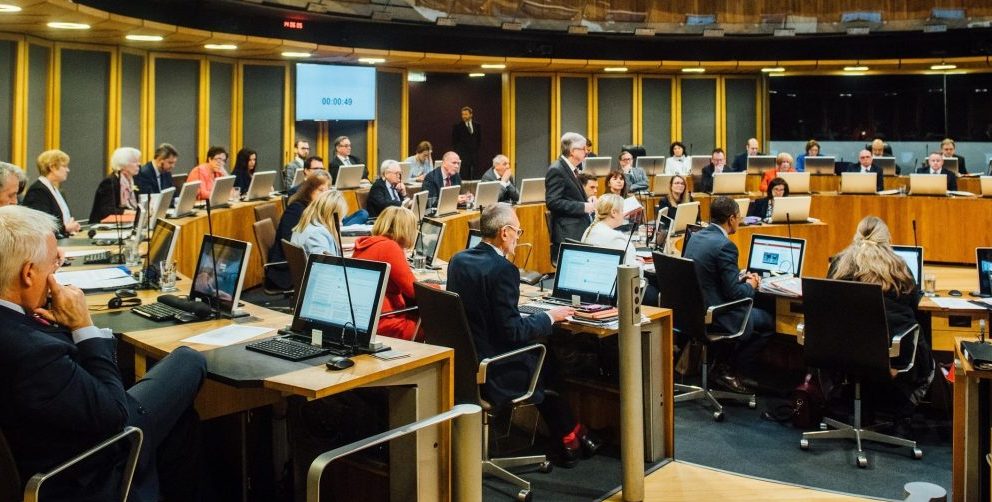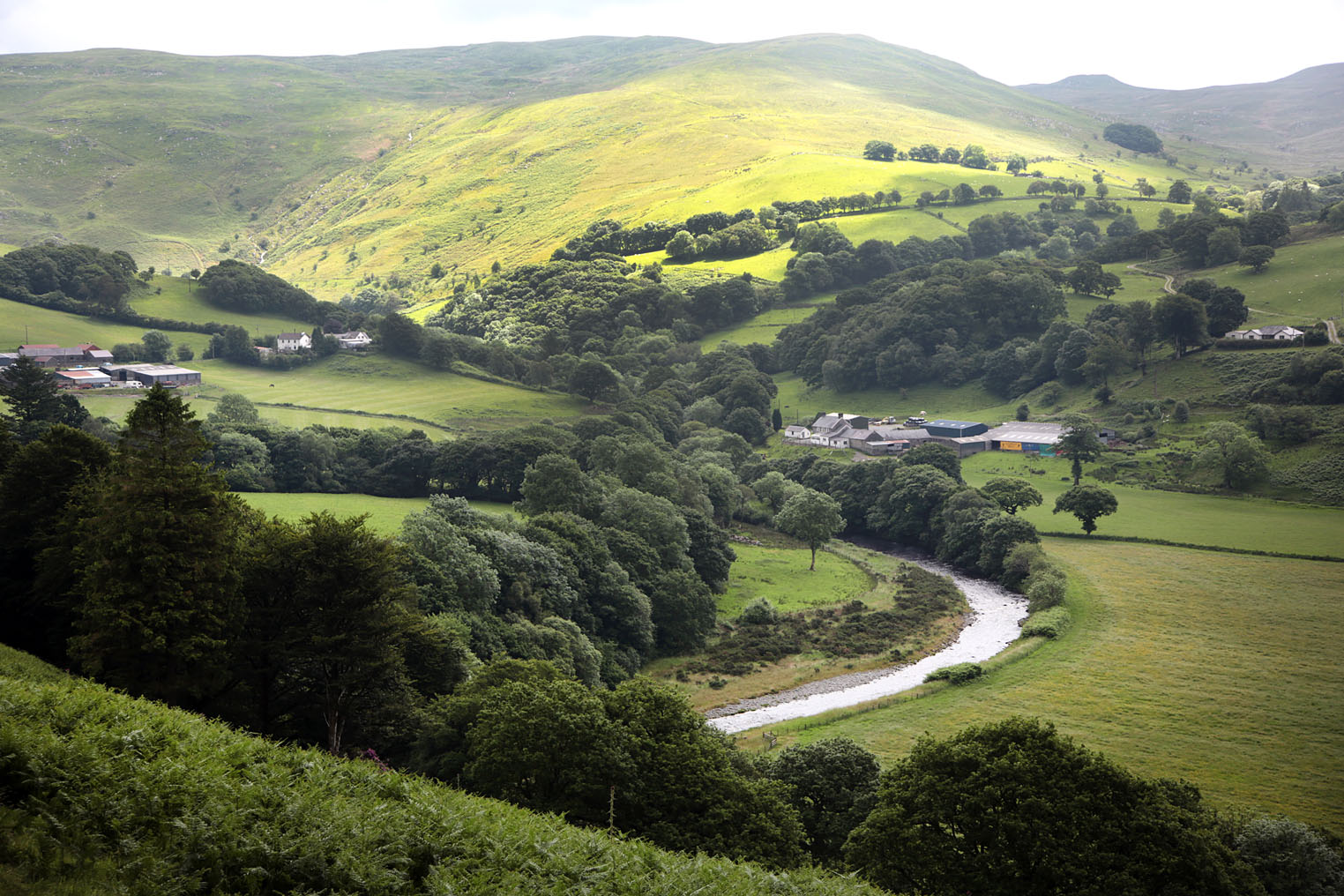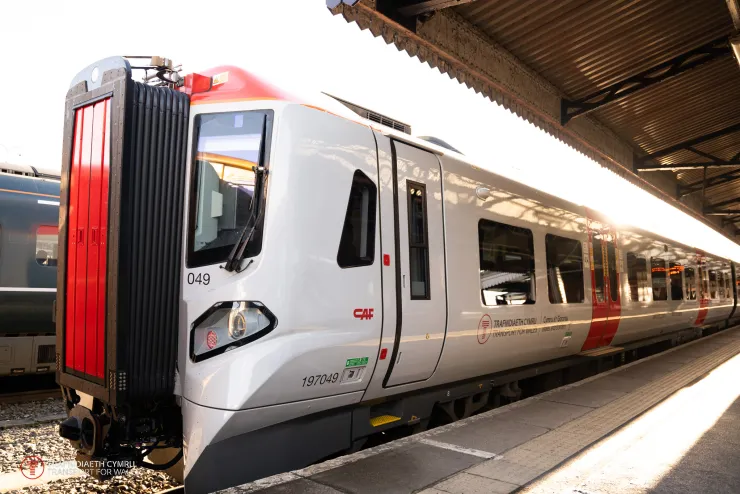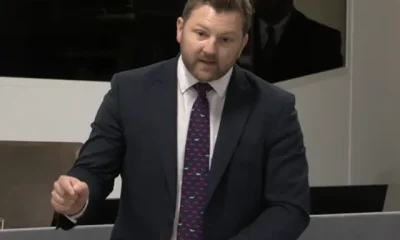News
Labour and Plaid agree on Senedd carve-up

LABOUR and Plaid Cymru this week pre-empted the results of a Senedd Committee’s enquiry and announced a huge increase in the number of Wales’s Senedd Members.
While the Special Purpose Committee on Senedd Reform continues to hear evidence ahead of its final report, Labour and Plaid announced they had agreed that Wales would elect 96 Senedd members instead of the current sixty at the next election.
Securing electoral reform and expanding the Senedd were Plaid Cymru manifesto commitments while expanding the Senedd was a Labour policy pledge.
However, the arrangements announced on Tuesday (May 10) are likely to increase questions about how accountable Senedd members are to their electorate.
FIXING THE SYSTEM
One of the key gripes of those in favour of Senedd reform is the abolition of regional members selected using Wales’s complex PR system.
The new arrangements will see 32 constituencies based on the new Westminster constituency boundaries electing three members each but grouped with six other constituencies to ensure seats are allocated (theoretically) more proportionately.
If that sounds complicated, the system will have one simple result.
It will sever the link between elected and electors.
Voters will vote for parties and not individuals. The party-list will decide who gets elected to represent you.
You will no longer have a say in the identity of your representatives.
Instead, the parties have all the power to decide who gets elected.
You’re made for life if you get in via the system proposed.
And if that sounds like modern Welsh democracy, it’s a very peculiar form of it.
The arrangement suits Labour as its voters won’t have any chance to vote for anyone else. In a properly proportional single transferrable vote system (STV), votes get the chance to rank their preferences.
Under the proposals, voters will vote for one party and whoever else gets elected depends on the system churning out results and favoured and otherwise unelectable party hacks.
Like most current regional members, Senedd Members elected under the proposed system will become
invisible in their communities.
MPs will have far greater local profiles.
Suppose the proposals want to encourage nation-building and create a stronger and more democratic Welsh Parliament. In that case, the results are likely to entrench Labour and Plaid in a permanently symbiotic relationship with very little chance for other parties to breakthrough.
It’s a system ripe for abuse by party managers and rooked to exclude small parties from any national say.
From Labour and Plaid’s perspectives, it will ensure the Conservatives are permanently excluded from power in Wales.
THE WIND OF CHANGE
First Minister Mark Drakeford said: “The case for Senedd reform has been made.
“We now need to get on with the hard work to create a modern Senedd, which reflects the Wales we live in today. A Parliament that truly works for Wales.
“The joint position statement we are publishing today will help support the important work of the cross-party Special Purpose Committee to move Senedd reform forwards.”
Adam Price, leader of Plaid Cymru, said: “These reforms will lay the foundations for a stronger Welsh democracy and a fairer, more representative Senedd that will look entirely different to the outdated political system at Westminster.
“A stronger, more diverse, more representative Senedd will have a greater capacity to perform its primary purpose of making a positive difference to the lives of the people of Wales.”
Ensuring that the Senedd is more diverse is an interesting step forward.
The statement detailing the proposals says that electoral law in Wales will include “integrated statutory gender quotas and mandatory zipping.”
The first part of that phrase indicates an aim to ensure equal representation between the genders in the Senedd.
The second part, “mandatory zipping”, requires parties to put forward equal numbers of male and female candidates and alternate between men and women when preparing their candidate lists.
If number one on the internal party list is male, the second is female, the third male, the fourth female &c.
It is unclear whether the Welsh Government has the legal power to force those measures.
Mark Drakeford and Ada Price wrote to the Reform Committee’s Chair, Huw Irranca-Davies, saying their proposals are “most likely to achieve the two-thirds Senedd majority required by law to deliver reform.
“We are confident that the statement below will enable you to make recommendations on these fundamental issues.”
DRAKEFORD AND PRICE “TRYING
TO STRONGARM COMMITTEE”
The Welsh Conservative response was swift.
Andrew RT Davies said: “Wales does not need more politicians in Cardiff Bay – we need more teachers, doctors, dentists, and nurses.
“While we have consistently objected to more politicians, we recognise Labour and Plaid have enough votes to push ahead.
“That’s why we have engaged constructively with the Senedd Reform Committee.
“Sadly, both parties have completely undermined the committee’s work with this announcement.”
Darren Millar, the Conservative Member of the Senedd Reform Committee, was even more scathing.
Announcing his decision to quit the Committee, he said: “It was extremely disappointing to see the Committee undermined by the publication of a joint position statement on Senedd reform by the First Minister and the Leader of Plaid Cymru.
“Issuing the position statement to the media in the absence of any written or oral statement to the Senedd was extremely discourteous to the Welsh Parliament.
“The publication of such a prescriptive statement before the Committee completes its work. However, this announcement effectively terminates its ability to draw independent conclusions.
“It is with regret that I have resigned from the Committee, but after the stunt pulled by the First Minister and Plaid’s leader, it has become futile.
“It is unacceptable that they have tried to strongarm the Committee by imposing their position in this way. Senedd committees should not be fettered in this way.
“We joined this committee and process in good faith as there was a mandate for change, but it looks like that was misplaced.”
The Reform Committee will report on May 31, but it looks like its decisions have been made for it.
Farming
Basic Payment Scheme 2025 balance paid to 95% of Welsh farmers

Final year of BPS as transition to Sustainable Farming Scheme begins
The WELSH Government says more than ninety-five per cent of farm businesses have now received their full or balance payment under the final year of the Basic Payment Scheme (BPS), ahead of the introduction of the new Sustainable Farming Scheme (SFS) in 2026.
Announcing the update on Friday (Dec 12), Deputy First Minister and Cabinet Secretary for Climate Change and Rural Affairs, Huw Irranca-Davies, confirmed that over 15,400 Welsh farm businesses have been paid £68.7m. This comes on top of the £160m issued in BPS advance payments since 14 October.
Final round of BPS payments
The Basic Payment Scheme, which has been the backbone of farm support in Wales for a decade, provides direct income support to help farmers plan and manage their businesses. BPS 2025 marks the last year in which full BPS payments will be made before the scheme begins to be phased out.
The Cabinet Secretary said officials would “continue to process the outstanding BPS 2025 claims as soon as possible,” adding that all but the most complex cases should be completed by 30 June 2026.
Payments issued today represent the main balance due to farmers following earlier advances, giving many businesses the cash flow they need during the quieter winter period—traditionally a challenging time in the agricultural calendar.
Shift to Sustainable Farming Scheme in 2026
From 1 January 2026, the Welsh Government will begin rolling out the Sustainable Farming Scheme, a major reform to how agricultural support is delivered. The SFS will reward farmers for environmental outcomes such as habitat management, carbon reduction and biodiversity improvements, alongside continued food production.
The government has argued that the new scheme is essential to meeting Wales’ climate and nature targets while ensuring long-term resilience in the sector. However, the transition has been closely watched by farming unions, who have raised concerns about the administrative burden, income stability, and the speed at which BPS is being phased out.
Mr Irranca-Davies reaffirmed the government’s stance, saying: “This government is steadfastly committed to supporting Welsh farmers to sustainably produce quality food. This is demonstrated today in our payment of the BPS 2025 balance payments and will continue throughout the transition period.”
Sector reaction
Farming unions are expected to scrutinise the detail of today’s announcement, particularly around remaining unpaid cases. Last year, late payments led to frustration in parts of the sector, with unions calling for greater certainty as the industry faces rising input costs, supply chain pressures and continued market volatility.
The move to the SFS remains one of the most significant agricultural policy changes in Wales since devolution. Ministers insist the shift is designed to support both food production and environmental stewardship, while critics warn the transition must not undermine farm viability—especially for family-run livestock farms that dominate rural areas such as Pembrokeshire, Ceredigion and Carmarthenshire.
What happens next
Farmers still awaiting their BPS 2025 balance will continue to be processed “as soon as possible”, the Welsh Government said. Officials will also publish updated guidance on the Sustainable Farming Scheme ahead of its launch.
The coming year will therefore become a pivotal moment for Welsh agriculture, as the long-standing BPS framework—which provided over £200m annually to Welsh farmers—makes way for a new results-based model that will shape the industry for decades to come.
News
Improved train timetable launches across Wales

Extra services, later trains and boosted Sunday routes as £800m rail investment takes effect
An improved train timetable has come into force across Wales today (Sunday, 14 December), with Transport for Wales (TfW) introducing more frequent services, stronger connections and additional late-night trains on key routes.
The winter timetable update brings one of the most substantial uplifts in recent years on the Wales and Borders network, forming part of the Welsh Government’s ongoing £800 million investment in brand-new rolling stock and reliability improvements.
More trains and later journeys
Among the upgrades, passengers will see:
- A new hourly additional service between Chester and Wrexham, effectively doubling the frequency on one of the region’s busiest commuter corridors.
- An extra train in each direction every day on the Heart of Wales line between Swansea and Shrewsbury.
- Three later last trains from Cardiff to Treherbert, Aberdare and Merthyr Tydfil, supporting shift workers and the night-time economy.
- A new hourly Sunday service on the Coryton line in Cardiff.
Cabinet Secretary for Transport and North Wales, Ken Skates, said improved connectivity was “absolutely vital” for economic growth and passenger confidence.
“These changes will make a real difference to customers, who will benefit from more services and greater connectivity,” he said. “This has been made possible by our £800m investment in brand-new trains for the Wales and Borders network.
“We will see the doubling of trains between Wrexham and Chester and a later service from the capital to valley communities. In South Wales, people will continue to benefit from simpler, fairer fares through TfW’s Pay As You Go service, and its forthcoming introduction in North Wales will help even more passengers access easy, transparent pricing.”
Full details of the updated timetable are available at: tfw.wales/service-status/timetables
News
Wrecked guard boat still under watch off north Pembrokeshire coast

Tidal changes monitored after dramatic early-morning rescue
A GUARD VESSEL that ran aground off the north Pembrokeshire coast in the early hours of Thursday morning (Dec 11) remains under close observation as tides continue to shift.
The Resolute, a 24-metre guard boat understood to be working for an offshore wind project off the Irish coast, had been sheltering in worsening weather when she was pushed onto rocks near Aber Hywel, Dinas, shortly after 3:25am.
Four crew members were onboard when the vessel grounded in rough seas and a strong southerly wind.

Major rescue effort launched
The crew issued an emergency alert, prompting a full multi-agency response.
A coastguard rescue helicopter, both Fishguard RNLI lifeboats, and coastguard teams from Fishguard and St Davids were sent to the scene.
Turbulent air made a winch rescue impossible and Fishguard’s all-weather lifeboat was unable to get close due to cliffs and submerged hazards. The inshore lifeboat was instead deployed to attempt a transfer in extremely challenging conditions.
During the evacuation, the third crew member descending to the vessel’s life raft slipped, fell into the water and was swept away. Speaking afterwards, RNLI crew member Cedwyn Rogers said the team immediately switched into “hyper-focused” mode as training took over.
Despite the casualty drifting, helm Warren Bean — a volunteer with more than 30 years’ RNLI experience — manoeuvred the lifeboat alongside, allowing crew to haul the man to safety. The remaining crew member was then retrieved, and all four were taken aboard the all-weather lifeboat and brought ashore to Fishguard.
All rescue units were later stood down.
Vessel still stranded and taking on water
The Herald understands that the Resolute remained aground on the rocks yesterday and was taking on water. The crew were later assisted back onboard by a local fisherman to assess damage on behalf of the vessel’s operators.
Management representatives from Ireland were due to arrive to draw up a recovery plan, including arrangements to remove fuel to prevent any potential environmental impact.
Further inspections have been taking place today as the team evaluates the next steps.
Coastguard statement
A spokesperson for HM Coastguard said: “At 3.28am on Thursday morning, HM Coastguard was made aware of a vessel with four persons onboard aground on rocks at Fishguard, Pembrokeshire. RNLI lifeboats and coastguard rescue teams from Fishguard and St Davids were sent to the scene. The four people aboard were rescued by lifeboat, and the helicopter was stood down. The vessel, which is still aground, is being monitored as tidal conditions change.”
-

 Crime5 days ago
Crime5 days agoPhillips found guilty of raping baby in “worst case” judge has ever dealt with
-

 Crime4 days ago
Crime4 days agoKilgetty scaffolder sentenced after driving with cocaine and in system
-

 Crime4 days ago
Crime4 days agoHousing site director sentenced after failing to provide breath sample following crash
-

 Crime4 days ago
Crime4 days agoMotorist banned for three years after driving with cannabis in system
-

 Education3 days ago
Education3 days agoTeaching assistant struck off after asking pupil for photos of her body
-

 News6 days ago
News6 days agoJury retires tomorrow in harrowing Baby C rape trial
-

 Crime4 days ago
Crime4 days agoMilford Haven pensioner denies exposure charges
-

 Local Government6 days ago
Local Government6 days agoNew defamation row erupts after anonymous website targets Herald editor

























